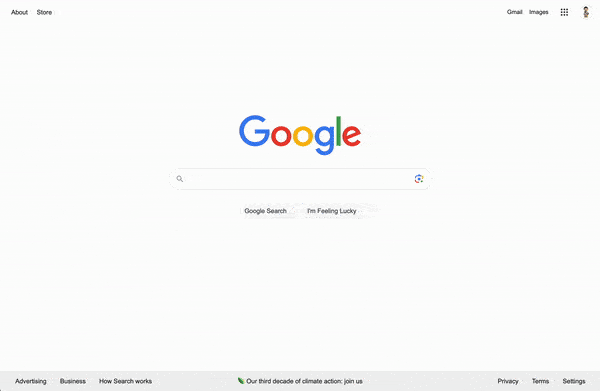Just like Thanos wiping out half of life in the universe – Google are using their infinity gauntlet to essentially bury your website – by bringing back pagination.
When starting out in marketing – a quote I used to like was ‘The best place to hide a dead body is page 2 of Google’. Now, this hasn’t been relevant for the last few years, as Google adopted an ‘Infinite Scroll’ function – popularised by Social Media channels, but Google have now revealed they’re bringing back pagination.
Yes – the infinity war analogy may have been dramatic – it’s not all doom and gloom – but there are definitely some pros and cons to this announcement.

Actual Footage Of Your Website Dropping onto Page 6 of Search Results
The official reason given by Google for this change is to speed up the delivery of search results. On the surface, this rationale seems straightforward. By eliminating continuous scrolling, Google aims to optimise the search process, potentially making it faster and more efficient for users.
Sign up to our newsletter to stay up-to-date with the latest trends and updates.
Just like Thanos wiping out half of life in the universe – Google are using their infinity gauntlet to essentially bury your website – by bringing back pagination.
When starting out in marketing – a quote I used to like was ‘The best place to hide a dead body is page 2 of Google’. Now, this hasn’t been relevant for the last few years, as Google adopted an ‘Infinite Scroll’ function – popularised by Social Media channels, but Google have now revealed they’re bringing back pagination.
Yes – the infinity war analogy may have been dramatic – it’s not all doom and gloom – but there are definitely some pros and cons to this announcement.

Actual Footage Of Your Website Dropping onto Page 6 of Search Results
The official reason given by Google for this change is to speed up the delivery of search results. On the surface, this rationale seems straightforward. By eliminating continuous scrolling, Google aims to optimise the search process, potentially making it faster and more efficient for users.
Sign up to our newsletter to stay up-to-date with the latest trends and updates.

However, the abrupt nature of this decision and its significant implications have led many in the search marketing field to question whether there might be underlying motives at play.
Continuous scrolling, or infinite scroll, became popular through social media platforms like Facebook and Instagram, where users enjoy an uninterrupted flow of content. When Google adopted this feature, it was seen as a progressive step towards modernising search engine results. Users could effortlessly browse through multiple pages of results, which not only enhanced their experience but also increased the chances of lesser-known websites getting noticed. This shift was particularly beneficial for small businesses and new websites trying to gain traction in a competitive online space.

Despite these apparent benefits, Google’s decision to end continuous scrolling suggests a complex landscape of priorities and concerns. While faster search results are undoubtedly appealing, there is a growing concern that this move might be more about Google’s internal strategies than about user experience. Some industry experts speculate that the real motivation could be tied to advertising revenue. With paginated results, users are more likely to click on ads placed at the top of each new page, potentially increasing Google’s ad revenue.
Moreover, this shift could have significant repercussions for search engine optimisation (SEO) and website traffic patterns. Continuous scrolling democratised visibility, allowing more websites to appear on the first scroll. Without it, the competition to rank on the first page of search results becomes even fiercer. Websites that fail to secure a spot on the first page may see a drop in their traffic and engagement metrics, which could negatively impact their overall SEO performance.
In light of these changes, the search marketing community is closely watching how this will unfold. Will the discontinuation of continuous scrolling truly result in faster search results, as Google claims? Or is this move a strategic play to reassert control over ad placements and search rankings? As Google transitions back to a paginated format, businesses and marketers will need to adapt their strategies to navigate this new search landscape.
When Google brought continuous scrolling to mobile search, it meant users could see up to four pages of search results without having to click a “Next” button. This change was particularly welcomed for several reasons:
Overall, Google’s adoption of continuous scrolling for mobile search results was seen as a progressive step towards improving both user experience and the visibility of a wider range of websites. It aligned search practices with modern browsing behaviors and offered numerous benefits that both users and website owners could appreciate.
Recently, The Verge reported that Google is removing continuous scrolling to improve the speed of search results. This change is hitting desktop searches first, with mobile searches to follow. Instead of endless scrolling, desktop users will see Google’s classic pagination bar, and mobile users will get a “More results” button at the bottom of the page.
While Google claims this change will speed up search results, many in the search marketing community are skeptical. There’s a concern that this move might be more about increasing ad visibility. The U.S. Department of Justice has even released emails showing Google executives discussing ways to show more ads in search results.
Brett Tabke, founder of the Pubcon search marketing conference, shared his thoughts on the end of continuous scroll:
“This change will likely mean more clicks on page one, leading to higher click-through rates for ads and Google properties. Organic search results could be pushed to page two, and maybe even to a separate domain in the future. This shift seems to be moving Google away from organic results and towards promoting its own content and ads.”
Many others share Brett’s skepticism. Social media is buzzing with opinions that Google’s change is more about boosting ad revenue than improving user experience. One user tweeted, “I wouldn’t be shocked if it was hurting bottom-of-the-page / top of page 2+ ad clicks,” while another said, “Why not just show one page with Google AI, Reddit, and the usual culprits? Who clicks on page 2 anyway?”
An anonymous account, “Google Honesty,” harshly tweeted, “Continuous scroll allows everyone to be on page one. We prefer to crush your spirit. It’s far more humiliating to be on page 6. Pagination in search allows this.”
Despite the skepticism, some see this change in a positive light. Kevin Indig pointed out on Twitter that continuous scrolling isn’t always a great feature. He tweeted, “Paginated SERPs are back! I’ve found continuous scroll to be a subpar solution for websites as well.”
Infinite scrolling works well on social media, where users enjoy aimless browsing. But for other types of websites, it can be a poor user experience. Purposeful browsing, like on ecommerce or informational sites, benefits from more structured navigation.
From an SEO perspective, the return to pagination has both pros and cons. On the plus side, this change could lead to faster page load times, which is a ranking factor. It can also improve user experience by making navigation clearer and more purposeful.
However, the downside is significant. With continuous scrolling, more sites had a chance to be seen. Now, with the return of pagination, the click-through rate (CTR) for non-high-performing pages is likely to drop. Pages that aren’t on the first page of results might see a decrease in visibility and traffic, which can be detrimental to their SEO performance.
In summary, while Google’s move to end continuous scrolling might speed up search results, it also raises questions about their true intentions and impacts on the search landscape. Whether this change is good or bad for users and site owners depends on perspective, but it’s clear that the SEO game is once again evolving.

However, the abrupt nature of this decision and its significant implications have led many in the search marketing field to question whether there might be underlying motives at play.
Continuous scrolling, or infinite scroll, became popular through social media platforms like Facebook and Instagram, where users enjoy an uninterrupted flow of content. When Google adopted this feature, it was seen as a progressive step towards modernising search engine results. Users could effortlessly browse through multiple pages of results, which not only enhanced their experience but also increased the chances of lesser-known websites getting noticed. This shift was particularly beneficial for small businesses and new websites trying to gain traction in a competitive online space.

Despite these apparent benefits, Google’s decision to end continuous scrolling suggests a complex landscape of priorities and concerns. While faster search results are undoubtedly appealing, there is a growing concern that this move might be more about Google’s internal strategies than about user experience. Some industry experts speculate that the real motivation could be tied to advertising revenue. With paginated results, users are more likely to click on ads placed at the top of each new page, potentially increasing Google’s ad revenue.
Moreover, this shift could have significant repercussions for search engine optimisation (SEO) and website traffic patterns. Continuous scrolling democratised visibility, allowing more websites to appear on the first scroll. Without it, the competition to rank on the first page of search results becomes even fiercer. Websites that fail to secure a spot on the first page may see a drop in their traffic and engagement metrics, which could negatively impact their overall SEO performance.
In light of these changes, the search marketing community is closely watching how this will unfold. Will the discontinuation of continuous scrolling truly result in faster search results, as Google claims? Or is this move a strategic play to reassert control over ad placements and search rankings? As Google transitions back to a paginated format, businesses and marketers will need to adapt their strategies to navigate this new search landscape.
When Google brought continuous scrolling to mobile search, it meant users could see up to four pages of search results without having to click a “Next” button. This change was particularly welcomed for several reasons:
Overall, Google’s adoption of continuous scrolling for mobile search results was seen as a progressive step towards improving both user experience and the visibility of a wider range of websites. It aligned search practices with modern browsing behaviors and offered numerous benefits that both users and website owners could appreciate.
Recently, The Verge reported that Google is removing continuous scrolling to improve the speed of search results. This change is hitting desktop searches first, with mobile searches to follow. Instead of endless scrolling, desktop users will see Google’s classic pagination bar, and mobile users will get a “More results” button at the bottom of the page.
While Google claims this change will speed up search results, many in the search marketing community are skeptical. There’s a concern that this move might be more about increasing ad visibility. The U.S. Department of Justice has even released emails showing Google executives discussing ways to show more ads in search results.
Brett Tabke, founder of the Pubcon search marketing conference, shared his thoughts on the end of continuous scroll:
“This change will likely mean more clicks on page one, leading to higher click-through rates for ads and Google properties. Organic search results could be pushed to page two, and maybe even to a separate domain in the future. This shift seems to be moving Google away from organic results and towards promoting its own content and ads.”
Many others share Brett’s skepticism. Social media is buzzing with opinions that Google’s change is more about boosting ad revenue than improving user experience. One user tweeted, “I wouldn’t be shocked if it was hurting bottom-of-the-page / top of page 2+ ad clicks,” while another said, “Why not just show one page with Google AI, Reddit, and the usual culprits? Who clicks on page 2 anyway?”
An anonymous account, “Google Honesty,” harshly tweeted, “Continuous scroll allows everyone to be on page one. We prefer to crush your spirit. It’s far more humiliating to be on page 6. Pagination in search allows this.”
Despite the skepticism, some see this change in a positive light. Kevin Indig pointed out on Twitter that continuous scrolling isn’t always a great feature. He tweeted, “Paginated SERPs are back! I’ve found continuous scroll to be a subpar solution for websites as well.”
Infinite scrolling works well on social media, where users enjoy aimless browsing. But for other types of websites, it can be a poor user experience. Purposeful browsing, like on ecommerce or informational sites, benefits from more structured navigation.
From an SEO perspective, the return to pagination has both pros and cons. On the plus side, this change could lead to faster page load times, which is a ranking factor. It can also improve user experience by making navigation clearer and more purposeful.
However, the downside is significant. With continuous scrolling, more sites had a chance to be seen. Now, with the return of pagination, the click-through rate (CTR) for non-high-performing pages is likely to drop. Pages that aren’t on the first page of results might see a decrease in visibility and traffic, which can be detrimental to their SEO performance.
In summary, while Google’s move to end continuous scrolling might speed up search results, it also raises questions about their true intentions and impacts on the search landscape. Whether this change is good or bad for users and site owners depends on perspective, but it’s clear that the SEO game is once again evolving.
Want to know more about this topic? Leave your details and your enquiry below and one of our Guru’s will be in touch!
